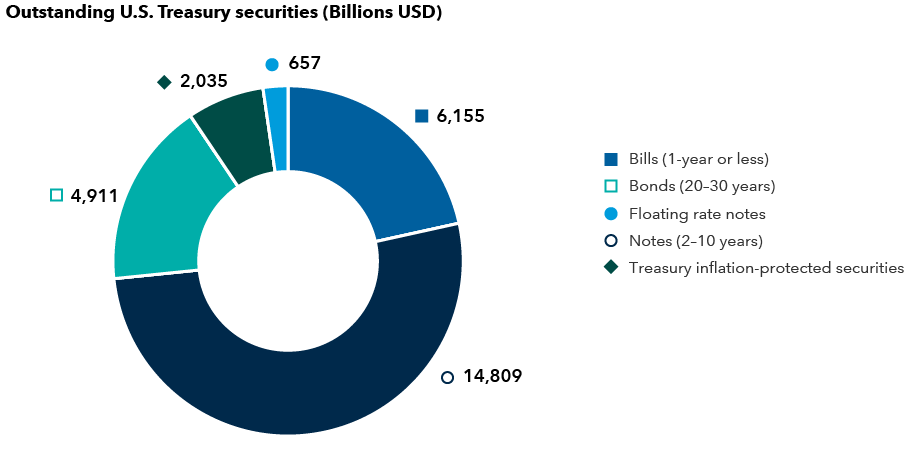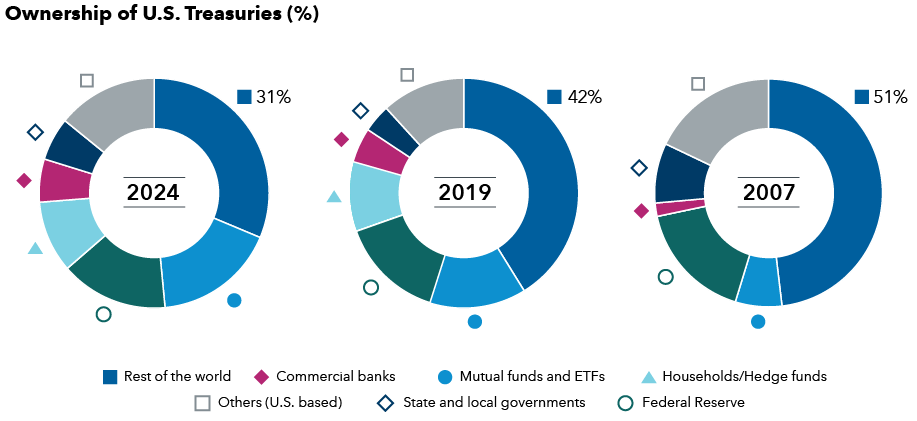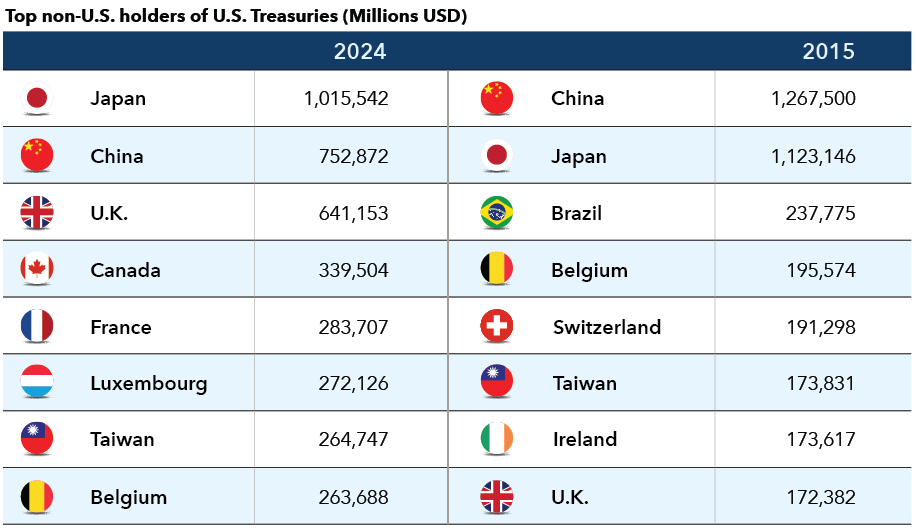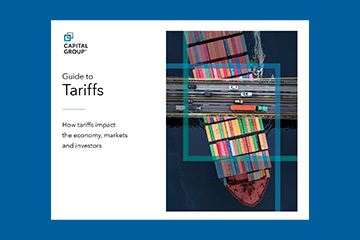Markets & Economy
The U.S. Treasury market has come under pressure after President Donald Trump’s sweeping tariff announcements triggered a widespread sell-off in bonds. As policy decisions with deep financial implications are rapidly made and reversed, it is understandable that holders of U.S. assets might feel a sense of unease.
Two factors are at play in the Treasuries market: the large volume of investments by hedge funds and other investors in highly leveraged trades, as well as foreign investors potentially stepping away to diversify assets from the U.S. Some investors have grown concerned that this turmoil could be on the verge of creating a liquidity event, where Treasuries cannot be easily bought or sold without causing significant price changes. Should the market reach a breaking point like during the COVID-19 pandemic, we think the Fed will be quick to react, but probably not with rate cuts, given the uncertainty surrounding future inflation.
Treasury market has remained functional so far
Liquidity has tightened and uncertainty remains high, especially given the ability for individual headlines to cause a severe repricing. But so far, bond markets have mostly continued to function in an orderly fashion.
Market stability improved after the 90-day pause on reciprocal tariffs was announced April 9. In addition, the U.S. government was able to auction $39 billion of 10-year Treasuries on April 9 and $13 billion of 30-year Treasuries on April 10, with solid results. However, there is still some uncertainty in the market. Yields on 10-year Treasuries have risen to near 4.4%.
Treasury market breakdown

Source: U.S. Treasury. Data as of February 28, 2025.
How much influence do non-U.S. buyers have?
There has been significant attention on non-U.S. investors selling Treasuries. Data is sparse in rates markets, but we have not seen evidence of widespread divestment by non-U.S. investors to date. However, there are signs that international buyers could be eschewing Treasury auctions as they diversify their reserves into other currencies. At the same time we're seeing long-term yields rise, we are also seeing the U.S. dollar weaken.
If global investors are beginning to shun the U.S. Treasury market, it would be cause for concern, as it takes away a large buyer and could put more pressure on rates. But when we're talking about any one individual actor dumping assets, it's worth pointing out that the holders of Treasuries are a lot more dispersed than they were even 10 years ago.
Treasury ownership has grown more diversified

Source: U.S. Treasury. Data as of February 28, 2025.

Source: U.S. Treasury. Data as of February 28, 2025.
What role are hedge funds playing?
The potential problems arising from hedge funds are varied and significant. Many market participants have singled out so-called “basis trades,” where investors buy a Treasury security and simultaneously sell a futures contract on that same security. These trades typically involve leverage, meaning investors borrow money to increase their positions. This can amplify gains but also losses. In aggregate, these trades represent around $800 billion in market value and serve the critical function of providing liquidity in the market. If many investors unwind their leveraged positions simultaneously, it could lead to a sudden and potentially severe liquidity shock, as we experienced in the COVID-19 pandemic. Other highly leveraged arbitrage trades, involving off-the-run issuances or swap spreads, have also been identified as potential contributors to the liquidity crunch.
What tools does the Fed have at its disposal?
In addition to its dual mandate of full employment and stable prices, the Fed also seeks to ensure market stability. We think that the Fed will be quick to interject if they deem the market is acting dysfunctionally or if there is something broken in the intermediation process. Susan Collins, head of the Federal Reserve Bank of Boston, reinforced this view on Friday, April 11, telling the Financial Times the central bank would “absolutely be prepared (to) address concerns about market functioning or liquidity, should they arise.”
Broad monetary policy tools like rate cuts or quantitative easing seem unlikely. Tariffs put the Fed in a difficult position. Their choice is between holding policy to fight inflation and risking a recession, or easing policy and risking inflation getting out of hand. We anticipate the Fed will emphasize inflation because unemployment is not an issue at this point, and we believe the Fed does not want to be seen as doing the bidding of the Trump administration. But the central bank has other ways of helping stabilize markets that have proven to be very effective historically. Some examples include:
- Repo operations: The Fed has used repo operations (short-term borrowing and lending transactions where securities are sold with an agreement to repurchase them at a later date) to manage short-term interest rates and provide liquidity. In 2019, the Fed stepped in to address a repo market blowout with $100 billion per day of overnight swaps and $60 billion per day of 14-day swaps.
- Standing repo facility: After the 2019 repo crisis, the Fed implemented a permanent facility to act as a ceiling on repo rates and provide liquidity to the financial system by allowing banks to borrow against their securities holdings.
- Temporary or permanent asset purchases: These are interventions, where the central bank buys assets to provide liquidity and stabilize the market. One example of this is when the Bank of England implemented a temporary program in 2022 to address a spike in gilt yields.
- Operation Twist: A $400 billion program used by the Fed in 2011 to support long duration U.S. Treasuries by selling short-dated instruments while keeping its balance sheet unchanged in size.
These sorts of programs can be quickly implemented. Other potential actions could include accelerating the end of quantitative tightening or loosening regulations to allow banks to hold more securities on their balance sheets. The Treasury also has a large degree of control over the debt management process. We still expect the status quo for bond auctions this year, but there is the potential to shift the supply mix to support certain parts of the curve.
However, these sorts of measures cannot address the lingering concern that political overreach may have reduced structural demand for Treasuries (similar to what happened in the U.K. when former Prime Minister Liz Truss announced a mini-budget calling for massive tax cuts in 2022). If this is indeed happening, it is not something the Fed will likely be able to fix over the long term.
Potential economic impact
Economic momentum is likely to soften, as tariffs pose a significant risk to consumer spending, which accounts for nearly 70% of U.S. GDP. They reduce purchasing power, given their inflationary effects, potentially lowering demand for goods and services. Even if tariffs are not fully passed onto consumers or are negotiated down from initial levels, their broader economic impact could heighten downside risks, especially if they provoke retaliation that reduces exports.
As such, recession risks appear to be rising, even as inflationary pressures are likely building. Our fixed income portfolio managers have generally been defensively positioned, in the context of their respective opportunity sets, through up-in-quality credit postures and rates positions designed to preserve portfolios in a risk-off scenario. We on the rates team believe the market’s fear over U.S. safe haven status is likely overblown. Duration appears more compelling now, given heightened downside risks. U.S. yields have gone higher despite a worrisome growth trajectory and look attractive on an inflation-adjusted basis compared to other developed markets.
Curve steepeners have benefitted from increased term premium and as a recession hedge. Importantly, the yield curve could steepen in multiple scenarios: 1) The Fed cuts into a growth shock even with higher inflationary pressures, or 2) Higher deficit and Treasury supply concerns, particularly if countercyclical spending measures are triggered, push yields higher on the long end, even if the Fed doesn’t cut.
Duration – A measure of a bond’s sensitivity to changes in interest rates. Generally speaking, a bond's price will go up 1% for every year of duration if interest rates fall by 1% or down 1% for every year of duration if interest rates rise by 1%.
Yield curve – The difference in bond yields (interest rates) of equal credit quality but differing maturity dates.
Curve steepener – A portfolio position that is designed to gain when the gap between short- and long-term yields grows.
Term premium – Compensation that investors require for bearing the risk that interest rates may change.
Off-the-run – Refers to U.S. Treasuries that are not the most recently issued. Some arbitrage trades attempt to capitalize on pricing differences between these securities and the most recent (on-the-run) Treasury issuances.
Swap spreads – The difference between the yield on a swap contract and the yield on a government bond of the same maturity.
Don't miss our latest insights.
Our latest insights
-
-
Emerging Markets
-
Global Equities
-
Economic Indicators
-
Get the Guide to Tariffs
Make sense of the tariff talk
RELATED INSIGHTS
-
Economic Indicators
-
Manufacturing
-
Don’t miss out
Get the Capital Ideas newsletter in your inbox every other week
 Tom Reithinger
Tom Reithinger
 Doug Kletter
Doug Kletter
